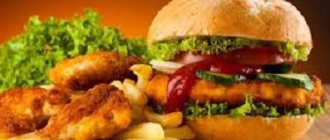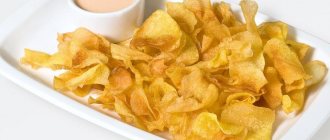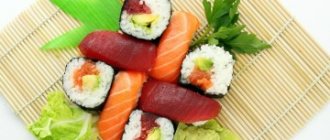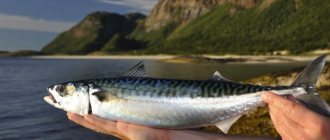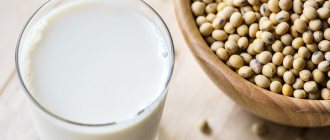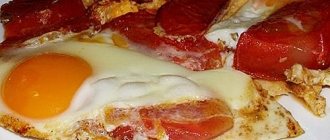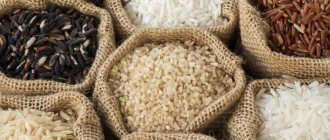Fish is valued by nutritionists much more than meat. Protein, healthy unsaturated fatty acids, vitamins, micro- and macroelements - its composition is most beneficial for the human body. Its soft and delicate taste, variety of varieties and dishes - all this makes it a welcome guest on any table.
At the same time, everyone is so accustomed to attributing it to dietary nutrition that they forget about the restrictions when losing weight. But, for example, 100 g of sterlet - 320 kcal, saury - 262 kcal, herring - 235 kcal. And they can easily ruin your figure. Low-calorie fish will help you stay within your daily caloric intake and not gain weight; you just need to know which specific varieties belong to it.
What does caloric content depend on?
Fat content
Low-calorie foods include fish and seafood, which contain no more than 100 kcal per 100 g of product. This concept should not be confused with fat content. Among the low-fat varieties there are many high-calorie ones: for example, beluga (147 kcal), sea bream (135), striped bass (124). And vice versa: there are low-calorie varieties with medium fat content: silverfish (84), sole (88), bighead (94). Among the fatty ones, we can mention the toothed greenling - it contains only 85 kcal.
Varieties
The same type of fish has many subspecies. Due to different habitats, diets and lifestyles, their calorie content may vary significantly. For example, ocean crucian carp belongs to low-calorie varieties (91 kcal), but Cape Cod carp no longer falls into this category (126). Or perch: Atlantic sea bass - 96, sea bass - 112, striped - 124. So, when looking for fish fillets for your diet in the store, you will have to clarify which subspecies it is.
Cooking method
The calorie content of fish directly depends on the method of its preparation. Compare: fresh pollock - 72 kcal, boiled - 79, baked - 80, hot smoked - 101, fried - 123, cold smoked - 141, salted - 235. Therefore, even the lowest calorie varieties cease to be dietary as soon as they are fried in oil, smoke or pickle.
Additional Ingredients
Calorie content depends not only on the cooking method, but also on what additional ingredients are in the recipe. For example, if you bake flounder in the oven with lemon, zucchini, tomatoes and eggplants, you will get a low-calorie dish weighing 60 kcal. But, if you fry the same fish in batter and a lot of oil, it will cost your diet 120 kcal.
Mayonnaise, heavy cream, oil for frying, breading, batter - all this will turn the most dietary seafood into a high-calorie bomb that will threaten your waist with extra centimeters. Vegetables, vinegar, lemon juice, dry white wine for sauce - look for only healthy ingredients in recipes.
Important conclusion. In connection with all of the above, and also taking into account that the calorie content of fish depends on many smaller factors (its habitat, nutrition, production methods of processing), please note that the lists and tables given below are conditional and very relative. The specific calorie content of a particular carcass can only be found in the store. It is indicated on the packaging or (if sold without it) in the accompanying documents.
Nutritional value, how many calories are in 100 grams
- Vitamin B1 is part of the most important enzymes of carbohydrate and energy metabolism, providing the body with energy and plastic substances, as well as the metabolism of branched amino acids. A lack of this vitamin leads to serious disorders of the nervous, digestive and cardiovascular systems.
- Vitamin B2 is involved in redox reactions, helps to increase the color sensitivity of the visual analyzer and dark adaptation. Insufficient intake of vitamin B2 is accompanied by impaired condition of the skin, mucous membranes, and impaired light and twilight vision.
- Choline is part of lecithin, plays a role in the synthesis and metabolism of phospholipids in the liver, is a source of free methyl groups, and acts as a lipotropic factor.
- Vitamin B5 is involved in protein, fat, carbohydrate metabolism, cholesterol metabolism, the synthesis of a number of hormones, hemoglobin, promotes the absorption of amino acids and sugars in the intestines, and supports the function of the adrenal cortex. A lack of pantothenic acid can lead to damage to the skin and mucous membranes.
- Vitamin B6 is involved in maintaining the immune response, processes of inhibition and excitation in the central nervous system, in the transformation of amino acids, the metabolism of tryptophan, lipids and nucleic acids, promotes the normal formation of red blood cells, and maintaining normal levels of homocysteine in the blood. Insufficient intake of vitamin B6 is accompanied by decreased appetite, impaired skin condition, and the development of homocysteinemia and anemia.
- Vitamin B12 plays an important role in the metabolism and transformation of amino acids. Folate and vitamin B12 are interconnected vitamins that are involved in hematopoiesis. A lack of vitamin B12 leads to the development of partial or secondary folate deficiency, as well as anemia, leukopenia, and thrombocytopenia.
- Vitamin D maintains calcium and phosphorus homeostasis and carries out the processes of bone tissue mineralization. A lack of vitamin D leads to impaired metabolism of calcium and phosphorus in the bones, increased demineralization of bone tissue, which leads to an increased risk of developing osteoporosis.
- Vitamin E has antioxidant properties, is necessary for the functioning of the gonads and heart muscle, and is a universal stabilizer of cell membranes. With vitamin E deficiency, hemolysis of erythrocytes and neurological disorders are observed.
- Vitamin PP is involved in redox reactions of energy metabolism. Insufficient vitamin intake is accompanied by disruption of the normal condition of the skin, gastrointestinal tract and nervous system.
- Potassium is the main intracellular ion that takes part in the regulation of water, acid and electrolyte balance, and is involved in the processes of conducting nerve impulses and regulating blood pressure.
- Calcium is the main component of our bones, acts as a regulator of the nervous system, and is involved in muscle contraction. Calcium deficiency leads to demineralization of the spine, pelvic bones and lower extremities, increasing the risk of developing osteoporosis.
- Magnesium is involved in energy metabolism, the synthesis of proteins, nucleic acids, has a stabilizing effect on membranes, and is necessary to maintain the homeostasis of calcium, potassium and sodium. A lack of magnesium leads to hypomagnesemia, an increased risk of developing hypertension and heart disease.
- Phosphorus takes part in many physiological processes, including energy metabolism, regulates acid-base balance, is part of phospholipids, nucleotides and nucleic acids, and is necessary for the mineralization of bones and teeth. Deficiency leads to anorexia, anemia, and rickets.
- Copper is part of enzymes that have redox activity and are involved in the metabolism of iron, stimulates the absorption of proteins and carbohydrates. Participates in the processes of providing oxygen to the tissues of the human body. Deficiency is manifested by disturbances in the formation of the cardiovascular system and skeleton, and the development of connective tissue dysplasia.
- Selenium is an essential element of the antioxidant defense system of the human body, has an immunomodulatory effect, and is involved in the regulation of the action of thyroid hormones. Deficiency leads to Kashin-Beck disease (osteoarthritis with multiple deformities of the joints, spine and limbs), Keshan disease (endemic myocardiopathy), and hereditary thrombasthenia.
- Zinc is part of more than 300 enzymes and is involved in the processes of synthesis and breakdown of carbohydrates, proteins, fats, nucleic acids and in the regulation of the expression of a number of genes. Insufficient consumption leads to anemia, secondary immunodeficiency, liver cirrhosis, sexual dysfunction, and the presence of fetal malformations. Research in recent years has revealed the ability of high doses of zinc to disrupt the absorption of copper and thereby contribute to the development of anemia.
more hide
You can see a complete directory of the healthiest foods in the “My Healthy Diet” app.
The calorie content of dried fish per 100 grams is 139 calories. Most of it is occupied by nutritious protein - there is almost 18 g of it, as well as fats - 4.7 g. Carbohydrates are completely absent - this is a feature of sea or freshwater fish.
The energy ratio of a 100-gram serving (BJU) is 22: 7: 0%.
The glycemic index is zero. According to doctors, seafood in moderation can be consumed by people with excess body weight, diabetes, and also following a diet, even a strict one. The fact is that fish meat, when entering the body, does not cause spikes in blood sugar, and also does not turn into fat deposits.
Meat that has undergone a dehydration procedure contains many valuable substances that have a beneficial effect on the cardiovascular and nervous system. Important elements are iodine, magnesium, Omega-3, Omega-6 fatty acids, which are so lacking in residents of non-coastal regions.
Full chemical composition:
- vitamin A;
- iodine;
- vitamin C;
- vitamin group B (B1, B2, B6);
- potassium;
- phosphorus;
- vitamin E;
- fluorine;
- phosphorus;
- iron;
- magnesium;
- vitamin PP;
- calcium;
- unsaturated fatty acids – Omega-3, Omega-6.
Freshwater or sea fish are rich in valuable microelements necessary for the normal functioning of the human body. So, in order to strengthen the skeletal system, it is important to consume foods containing fluoride, zinc, iron, phosphorus - seafood is rich in these components.
Fish prepared in a special way retains the entire vitamin and mineral complex and, importantly, unsaturated fatty acids necessary for both children and adults.
Dried fish is a good prophylactic against heart attack, stroke, and other vascular and heart diseases, and stimulates brain activity.
The product relieves depression, for example, during pregnancy, and also has an anti-inflammatory effect aimed at destroying cancer cells.
The walls of blood vessels become denser, which reduces the risk of blood clots and cholesterol plaques. Fish prevents the development of Alzheimer's disease and other aging ailments and is a dietary product due to its low calorie content and high content of easily digestible protein. Thanks to it, protein reserves in the body are replenished, thereby providing a rejuvenating effect, protein synthesis increases by about 30% due to fatty acids.
By culinary standards, this food has a fairly high calorie content. Therefore, those who have to pay attention to this indicator will need a gentle cooking method.
Contains 105 kcal per 100 g of its weight.
After drying
The calorie content of dried bream is 221 kcal per 100 g.
Glycemic index – 0.
Contains 221.21 kcal.
Contains 196 kcal.
The calorie content of hot smoked bream is 172 kcal.
The calorie content of cold-cooked fish is 160 kcal.
Calorie content – 107 kcal.
Calorie content – 85.6 kcal.
After drying
Contains 196 kcal.
| Property | Meaning |
| Calorie content, kcal | 88 |
| Proteins, g | 17,5 |
| Fats, gr | 2 |
List
Let’s immediately limit the search to a list that includes low-calorie varieties of fish (we selected the most popular ones, that is, available in almost any store, regardless of the region):
- vobla;
- sea bream;
- asp;
- flounder, crucian carp, rudd;
- lemonema;
- pollock, sea bass, sole;
- navaga;
- haddock, blue whiting;
- carp, herring;
- tilapia, silver carp, cod;
- trout.
If we take specific varieties of these varieties, they are given in the table below along with their calories. Almost all low-calorie fish is white. The only red one on this list is trout (salmon family), but even with it, not everything is so simple. Its calorie content depends on the habitat, subspecies, and production processing. Some manufacturers indicate 97 kcal on the packages, others - 147. Therefore, look at this indicator when purchasing a carcass.
Important note! All these varieties of fish are low-calorie when fresh. Most of them retain this status when boiled, steamed and baked. When fried, smoked, canned (especially in oil), salted and pickled, they lose this property.
As for seafood, almost all of it is low in calories if cooked correctly. The exception is caviar and sea cocktails in oil.
Low calorie varieties
Depending on the fat content, there are several varieties of fish: low-fat (up to 4%), moderately fatty (from 4 to 8%) and fatty (more than 8%). The list of low-calorie fish includes crayfish and shellfish of any kind. Low-fat varieties of fish are especially recommended for children, obese and elderly people, pregnant women, and patients with stomach ulcers.
Here is a list of low-calorie fish:
- river: perch, bream, pike perch, ruff, tench, pike;
- marine: cod, silver hake, blue whiting, pollock, navaga, pollock, roach, sea bass, haddock.
Which fish is considered the lowest in calories? This question is often asked by women who want to make their figure slimmer. Cod contains the least amount of fat (about 0.3%), so it is very popular among dietary products and is considered the lowest-calorie fish.
In second place after cod, you can safely put pollock and haddock, they contain from 0.5 to 0.9% fat.
TOP 3
1 place. Macrurus
The lowest-calorie fish is small-eyed grenadier (32 kcal). It is not often found on store shelves. This is due to the fact that it is found mainly in the Pacific Ocean, and its fishing presents many difficulties, since it is a deep-sea inhabitant. Today, fish farms are trying to solve this problem, since the demand for this variety has sharply increased: it contains a large amount of proteins and vitamins, but little fat.
The grenadier has one more advantage - its carcass is practically boneless (of course, not counting the backbone), thanks to which it is quickly cut and conveniently cut into portions.
It is better not to stew or cook grenadier, as it becomes jelly-like. Bake in the oven or use as a filling.
2nd place. Mascot
49 calories. In second place after grenadier. Unfortunately, it is also a rare guest on the shelves of our stores, since the main fishery is carried out off the coast of Norway and North-West Africa. On packages and price tags, the talisman may appear under other names: smoothhead, Baird's Pleshan, Baird's smoothhead, Baird's alepocephalus. The meat is watery, so when boiled it can easily turn into porridge. The best cooking method is baking with vegetables.
3rd place. Lemonema
Another dietary fish (67 kcal), closing the top three. It can be easily found on store shelves, since the fishery is well developed in Russia. It has tender meat and few bones. You are not limited in the choice of cooking methods: it is equally good in soups, stewed, baked, boiled, and even as part of everyone’s favorite sushi.
Among seafood, the lowest in calories are kelp (5 kcal), ascidians (20) and mussels (50).
How to store
Fresh and chilled whitefish are stored in the refrigerator at a temperature of 0°C to 2°C for no more than 2 days. The shelf life of fish in the freezer is unlimited. Ready-made fish dishes can be stored at temperatures close to 0°C for no more than a day.
If the question is how to preserve salted whitefish, you should place it in parchment paper or an enamel container and leave it in a cool room or refrigerator. The same applies to cold smoked products. Shelf life – up to 8 days.
Baked whitefish
To preserve the nutritional qualities of fish for a long time, salted, hot or cold smoked, dried fish is frozen. The shelf life of such products is unlimited.
Advantages and disadvantages
What is good about low-calorie fish:
- contains easily digestible protein, minerals, healthy fatty acids, vitamins (A, all group B, D, C);
- fits into the framework of weight loss diets, treatment tables and a proper nutrition system;
- included in the menu of pescatarians (a branch of vegetarianism), preventing them from developing anemia, vitamin deficiencies and protein deficiency;
- reduces cholesterol;
- reduces the risk of developing CVD;
- useful when playing sports against the background of dietary nutrition: prevents the breakdown of muscle fibers;
- improves digestion;
- has a positive effect on the nervous system;
- helps with thyroid diseases;
- speeds up metabolism.
What disadvantages should you be aware of:
- inferior in taste to high-calorie fish, as it is more watery;
- not as nutritious;
- There are practically no red fish among low-calorie varieties;
- may contain harmful substances (even mercury) if found in polluted areas;
- increases the risk of developing helminthiasis;
- is a powerful allergen;
- may cause unwanted side effects - poisoning, intestinal disorders, diarrhea.
For fish to be beneficial, it must be chosen and prepared correctly.
Cooking methods
The excellent taste of whitefish meat has made it popular in cooking since ancient times. The fish is fried, baked, stuffed. Salmon acquires a special taste when smoked. Lightly salted whitefish with spices is a favorite dish of the indigenous peoples of the North.
A very simple recipe for fried whitefish
Gourmets highly value steaks baked with potatoes and vegetables. The fish soup made from this fish is not inferior in taste, aroma, and richness to the sturgeon fish soup. In addition to tasty, tender meat, whitefish caviar is famous. Cheaper than other salmon, it is not inferior to them in taste and health.
Useful tips
How to choose
Signs of quality fish:
- gills shiny, with a reddish tint;
- eyes bulging, clear;
- scales without damage;
- meat without spots, dense, elastic;
- The color of the meat is light, uniform, without yellowness or greyness.
Take either carcasses without heads (this is where the largest amount of toxins accumulates) or boneless fillets.
How to cook
- Defrost completely. It cannot be re-frozen.
- Rinse thoroughly in several waters.
- Pre-soak river fish for a couple of hours in a vinegar solution to remove the smell of mud.
- Cut carcasses and pieces for better boiling.
- Without salt and spices, the fish tastes too bland.
- It is better to boil and steam by adding carrots, onions, parsnips, parsley and celery (roots), bay leaves and allspice to the water.
- Fish broth is also considered dietary. To make it transparent, a special “draw” (whites with cold water) is prepared.
As it is
- When losing weight and as part of proper nutrition, it is combined with vegetable salads, stews, legumes, brown rice and buckwheat.
- Does not combine with potatoes, cabbage and pasta.
- It is better to eat for dinner, but 3-4 hours before bedtime.
- Serving size: 200-250 g.
- Frequency - 2-3 times a week.
To lose weight, you can choose a special fish diet, and in this case, low-calorie varieties will come in handy.
Steamed fish
Steaming foods is one of the best ways to preserve their nutrients.
Steamed
fish , because it contains no fat or oil.
For those who want to lose weight or have diseases of the gastrointestinal tract, this type of heat treatment is the most acceptable when cooking. An indispensable kitchen appliance in a modern kitchen - a multicooker will help you pamper yourself and loved ones with dietary dishes.
100 grams of steamed fish - 174 kcal.
Recipes
Since fish loses its low calorie content when fried, it is better to cook it in the oven. Baking in foil will ensure the safety of all useful substances. Seafood makes excellent salads.
- Flounder baked with tomatoes (57 kcal)
Rub 0.5 kg of gutted flounder on all sides with pepper and salt (any spices to your taste). Pour in 100 ml lemon juice. Cover and refrigerate for a couple of hours. Place on a baking sheet greased with oil. Cut 300 g of tomatoes into large circles - this will be the top layer. Place in the oven (180°C) for 35 minutes.
- Macrurus baked in tomato juice (56 kcal)
Cut 1 kg of gutted grenadier into portions. Rub with pepper, salt, and spices to your taste. Pour in 100 ml lemon juice. Cover and leave under the marinade for a quarter of an hour. Place on a greased baking sheet in layers: grenadier, grated carrots (200 g), diced leeks (150 g), chopped basil (20 g). Sprinkle lemon juice on top. Pour a glass of tomato juice with pulp. Place in the oven (180°C) for half an hour.
- Cod baked in foil in French (92 kcal)
Cut 0.5 kg fillet tracks into portions. Rub with pepper, salt, spices to your taste, sprinkle with lemon juice. Boil 100 g of carrots and 400 g of potatoes in advance, cool, and cut into small pieces. Spread foil on a baking sheet. Place the cod on it, surround it with chopped vegetables, and cover with onion rings (150 g) on top. Sprinkle with thyme. Mix 50 ml of dry white wine and 150 ml of 10% cream. Pour the mixture over the cod. Wrap the foil. Place in the oven (190°C) for 25 minutes.
- Lenten seafood salad (94 kcal)
Boil water, salt it, add bay leaves and allspice. Boil 200 g of mussels, 400 g of squid and 100 g of shrimp in it. Cool seafood. Cut the squid into small cubes. Grind 100 g of onion. Peel and seed 120 g of ripe pear and cut into cubes. Mix 40 g of Dijon mustard with 20 ml of lemon juice and 15 ml of olive oil. Mix all ingredients thoroughly. The salad, despite its low calorie content, is suitable for a holiday table.
Tables
To make it more convenient to calculate your daily caloric intake, print out tables with the lowest calorie seafood and fish varieties.
Low-calorie seafood table
Table of low-calorie fish varieties
Calorie table for fish of the salmon family
Since the top sellers are salmon and some cannot live without red fish, we suggest that you familiarize yourself with the calorie content of representatives of this family in order to take it into account in your daily balance. Don't forget that most of them are medium-fat and fatty varieties.
Fish and seafood must be present in a healthy and balanced diet as healthy protein products. And if they are also low-calorie, you don’t have to worry about your figure and diversify your diet with delicious dishes.
